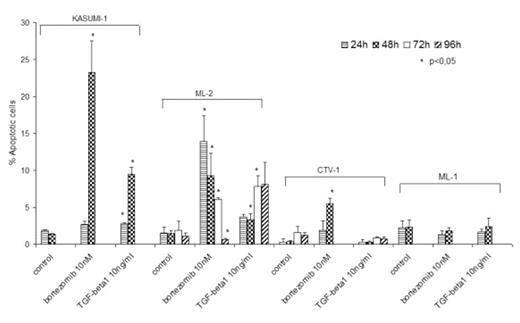Abstract
Bortezomib (N-pyrazinecarbonyl-L-phenylalanine-L-leucine boronic acid; VELCADE, formely known as PS-341 or MLN-341; Millenium Pharmaceuticals, Inc., Cambridge, MA) is a potent and specific proteasome inhibitor. It is the first member of proteasome inhibitors which obtained approval as chemotherapeutic agent for the treatment of relapsed or refractory multiple myeloma. First clinical experience of bortezomib in patiens with follicular lymphoma and mantle cell non-Hodgkin lymphoma suggest that bortezomib is well tolerated and has significant single-agent activity. Several phase I trials on the use of bortezomib as a novel treatment strategy in leukemia have been started. We studied the effect of of bortezomib and of transforming growth factor-beta (TGF-β) on induction of cell cycle arrest and apoptosis in human leukemia cells (ML-1, ML-2, CTV-1 and KASUMI-1) established from the peripheral blood of patients with acute myeloid leukemia (AML). [6-3H] thymidine incorporation was used as a measure of DNA synthesis to estimate cell proliferation. Apoptosis was detected by flow cytometry using annexin V-FITC/propidium iodide assay and results were confirmed by cell cycle analysis. The profiles of cellular DNA contents indicated the distribution of the cells in different phases of the cell cycle and any possible DNA loss due to DNA fragmentation during apoptosis. The cells with a DNA content less than that of G1 cells were considered as apoptotic cells. Statistical significance of the experimental results was analyzed by Student’s paired t-test. Leukemia cells were preincubated for 24–96 h without addition (control) or with bortezomib (4 nM or 10 nM) or with TGF-β1 (5 ng/ml or 10 ng/ml). TGF-β1 inhibited DNA synthesis only in KASUMI-1 cells but not in other leukemia cells used. Bortezomib (10 nM) was potent inhibitor of DNA synthesis in all four types of leukemia cells and induced apoptosis in KASUMI-1, ML-2 and CTV-1 cells but not in ML-1 cells [Figure 1]. Kinetics of apoptosis was different in individual cell lines. The peak of apoptosis was reached in 24 h in ML-2 cells, however in KASUMI-1 and CTV-1 cells in 48h. KASUMI-1 cells were most sensitive to bortezomib. In addition KASUMI-1 and ML-2 cells were also sensitive to induction of apoptosis by TGF-β1 but in lesser extent than by bortezomib [Figure 1]. Kinetics of apoptosis induction by TGF-β1 was slower than with bortezomib and lasted 48–96 h. Different sensitivity of human leukemic cell lines to bortezomib likely mimics behaviour of primary leukemic cells of patients and thus limits the use of proteasome inhibitors in therapy.
Disclosures: This study was financially supported by the Internal Grant Agency of the Ministry of Health, Czech Republic (NR 9045-3) and VZ MZ CR 00023736.; This study was financially supported by the Internal Grant Agency of the Ministry of Health, Czech Republic (NR 9045-3) and VZ MZ CR 00023736.
This study was financially supported by the Internal Grant Agency of the Ministry of Health, Czech Republic (NR 9045-3) and VZ MZ CR 00023736.
Author notes
Corresponding author


